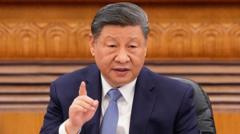US President Trump's recent tariff imposition could be seen as an aggressive maneuver against China, even as Beijing vows to retaliate. With escalated tariffs affecting not only Chinese imports but also South East Asian nations positioned in China's supply chain, the unfolding trade war signals significant challenges for regional economies.
Trump's Tariff Strategy: A Hard Hit on China's Supply Chain

Trump's Tariff Strategy: A Hard Hit on China's Supply Chain
As tariffs rise, the US aims to reshape trade dynamics in Asia, putting pressure on China's economy and its relationships with neighboring countries.
In his latest address, US President Donald Trump announced a sharp increase in tariffs that he claims will counteract China's trade advantages over the United States. With strong rhetoric, he detailed a plan that charges China a reciprocal tariff of 34%, asserting that the country has excessively benefited from US trade practices. His approach has elicited immediate backlash from China, which described the tariffs as "unilateral bullying" and promised "resolute countermeasures."
Trump's tariffs, which have escalated to an alarming 54% on Chinese imports, come on top of existing levies and target not just China, but extend to other South East Asian nations like Vietnam, Laos, and Cambodia. Experts suggest that these tariffs effectively curb China's strategies to circumvent previous trade barriers by relocating production to countries with less stringent tariffs.
Trade analysts like Deborah Elms from the Hinrich Foundation highlight the rapid build of tariffs on China as a genuine concern for Beijing, bracing it for immediate retaliation. Stephen Innes of SPI Asset Management characterized this tariff strategy as a comprehensive assault on China's associated supply chains, arguing that the consequences could be dire for Vietnam and its neighbors, which rely heavily on Chinese investment.
These tariff escalations could also have adverse implications for US businesses operating within South East Asia. Major American companies such as Apple and Nike, which have manufacturing facilities in Vietnam, are undeniably at risk. A survey indicated a looming threat of job cuts among US manufacturers in the region should these tariffs persist.
As China contemplates its next moves, the prospect of retaliatory tariffs looms large. Experts suggest Beijing must navigate difficult decisions during this period of heightened economic distress, with limited options available to mitigate the impending tariffs' impacts effectively.
In light of these developments, China may look to enhance partnerships with other affected Asian nations as a way to bolster resistance against US protectionist measures. Discussions between China, South Korea, and Japan regarding a potential free trade agreement exemplify this shift toward regional solidarity as they seek to counter America's tariff implications.
While the road ahead appears fraught with challenges, a resolution may eventually emerge from renewed negotiations between the US and China, even if temporary discomfort is on the horizon. Amid these evolving trade dynamics, analysts anticipate a tumultuous period for both US imports from China and South East Asian economies intertwined with the complexities of global trade.




















